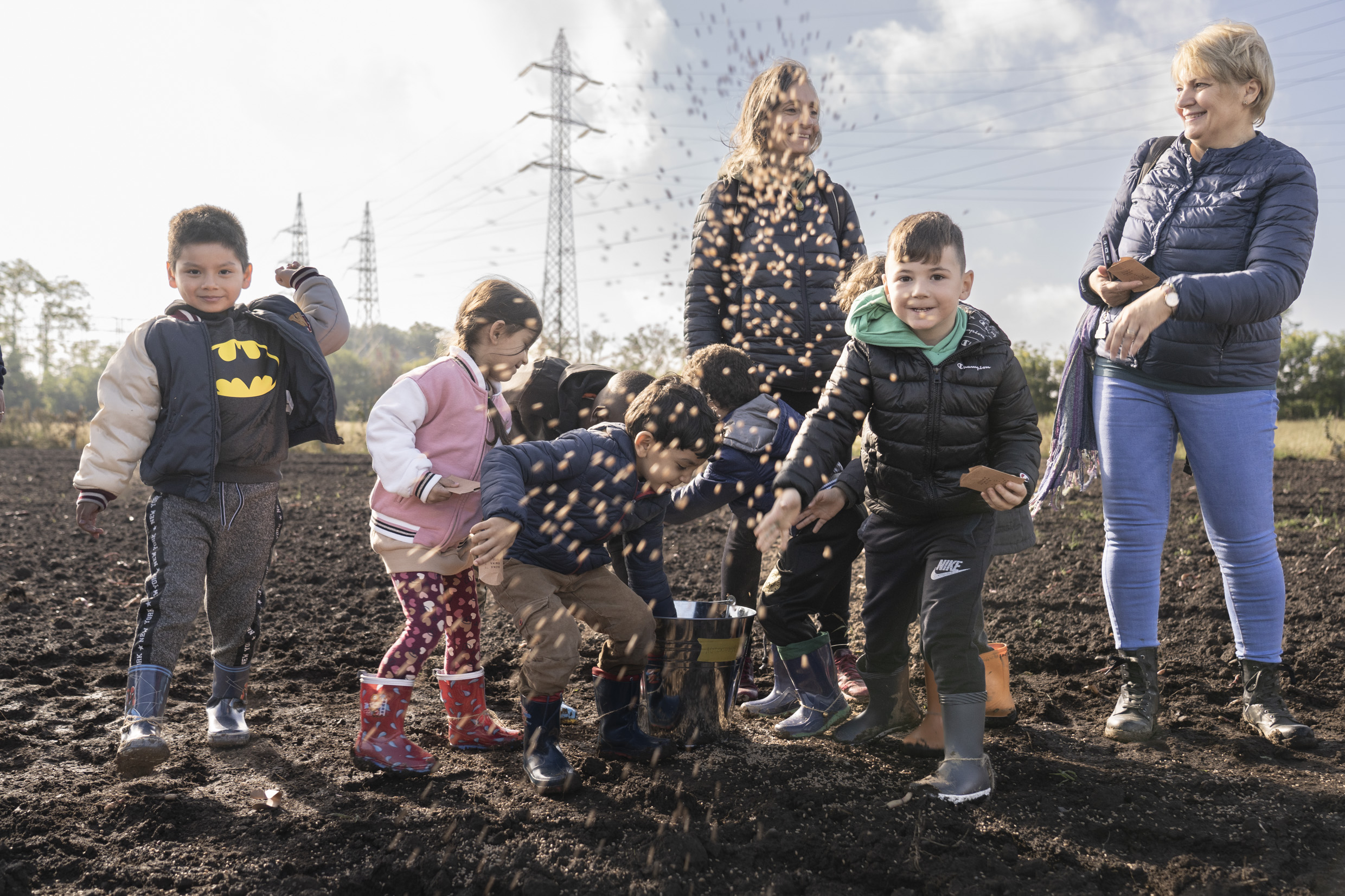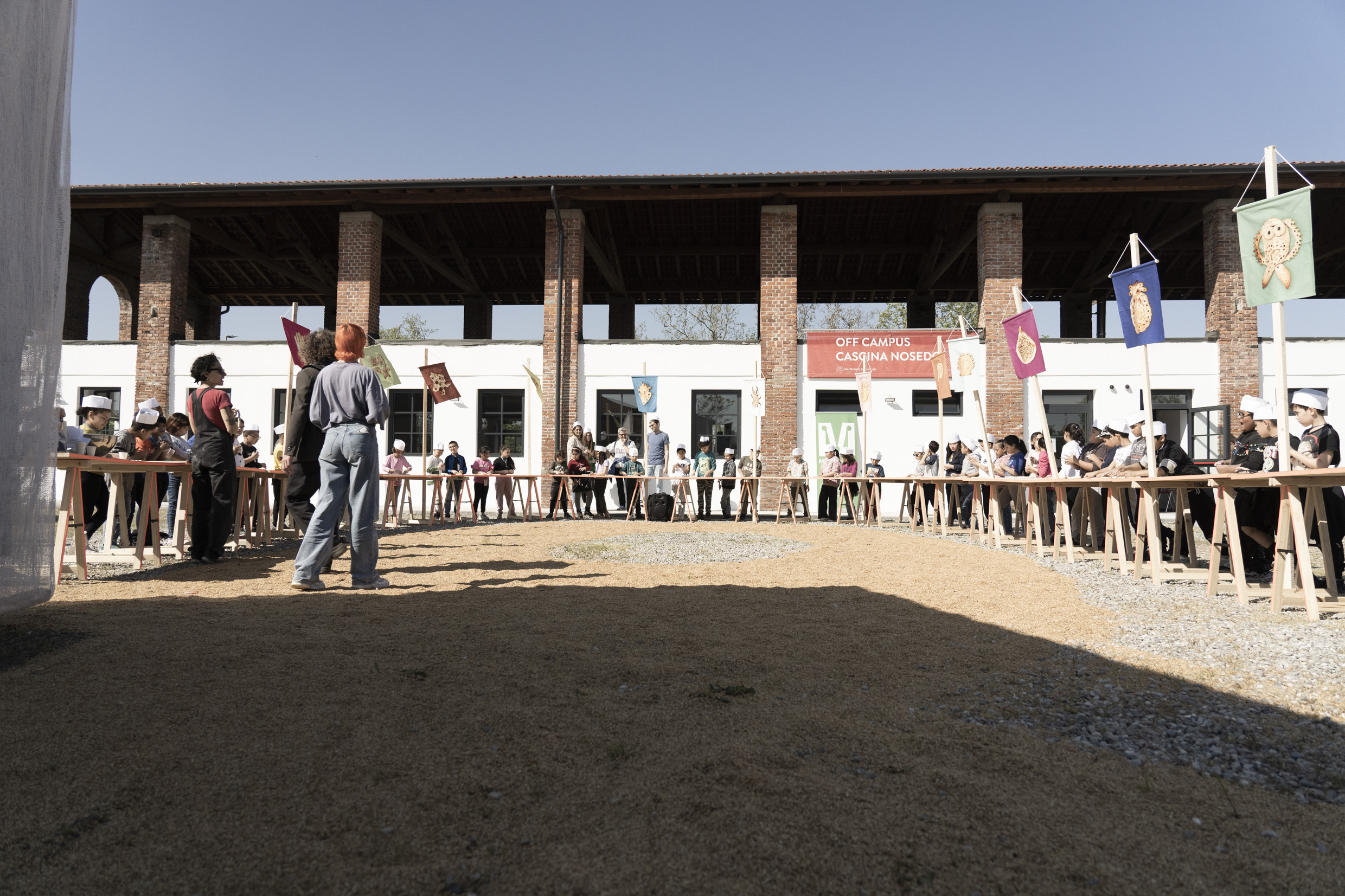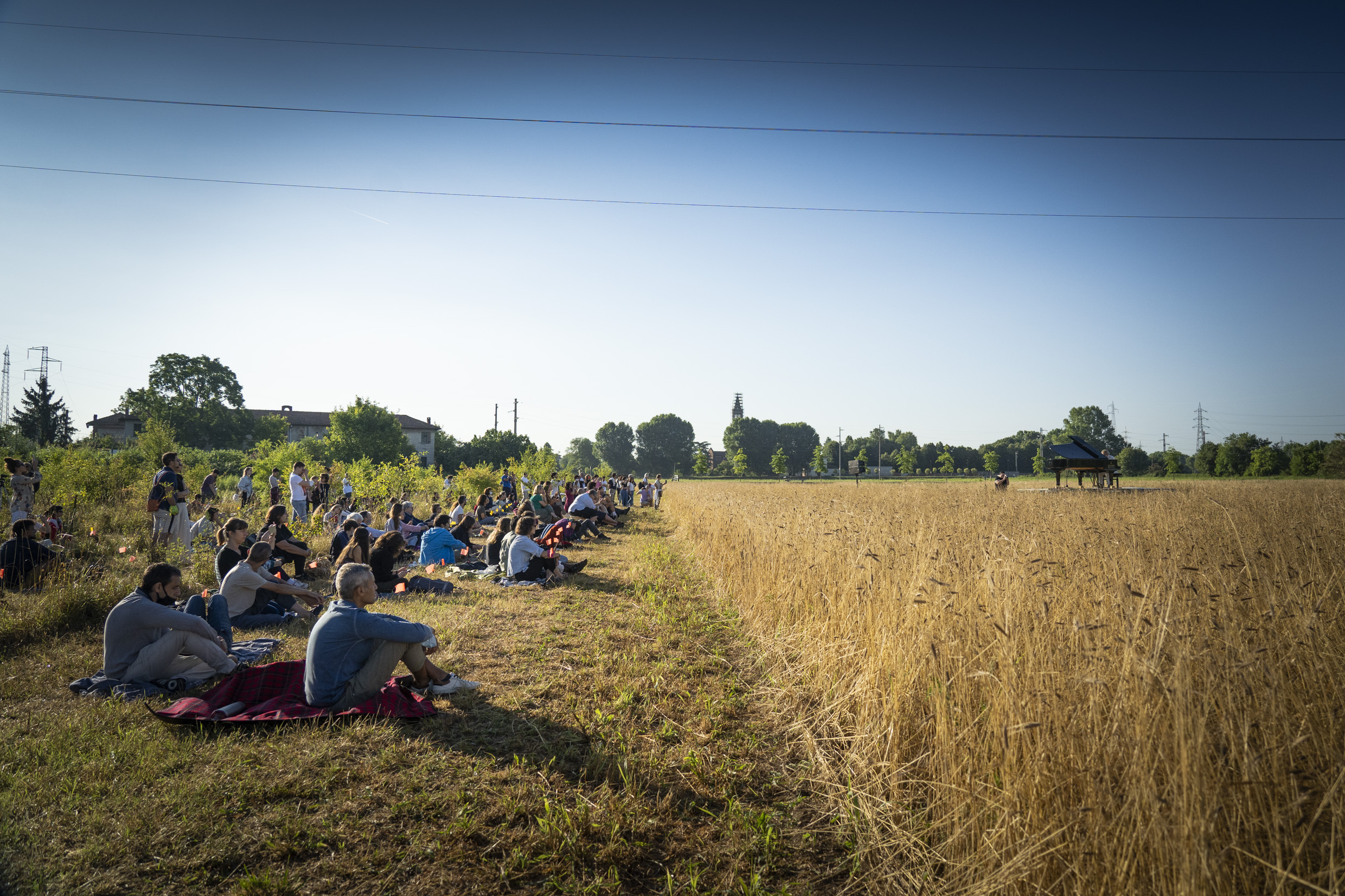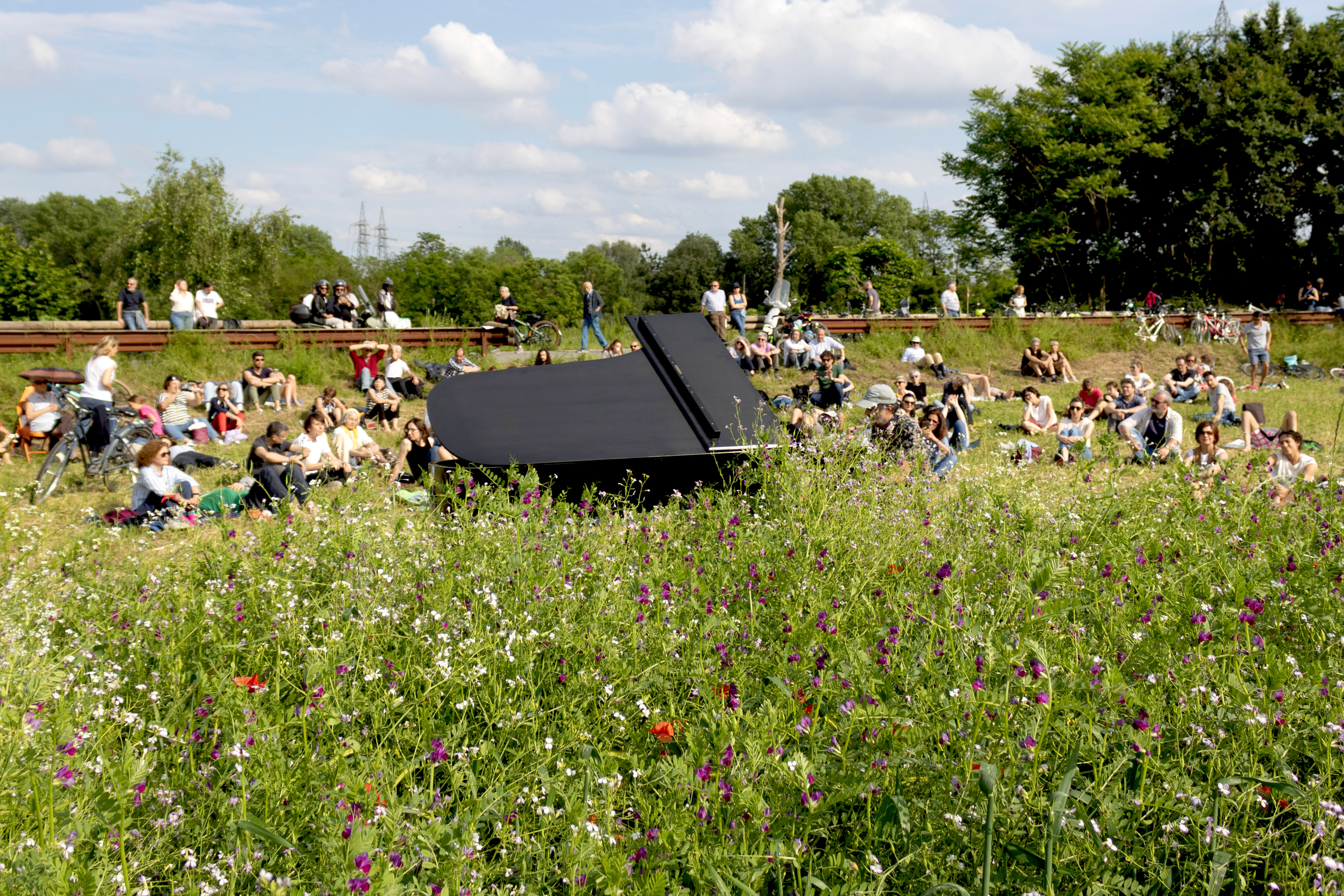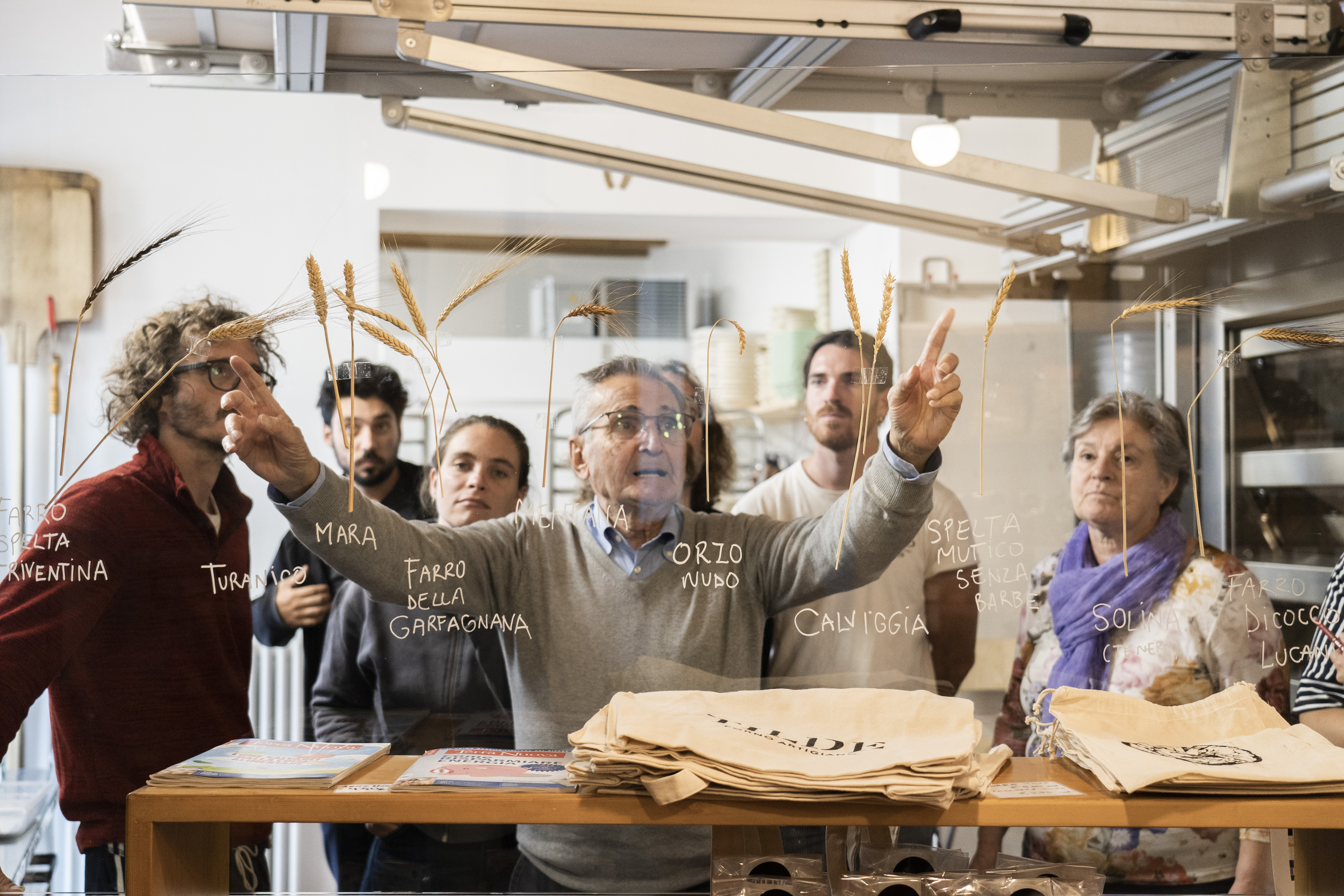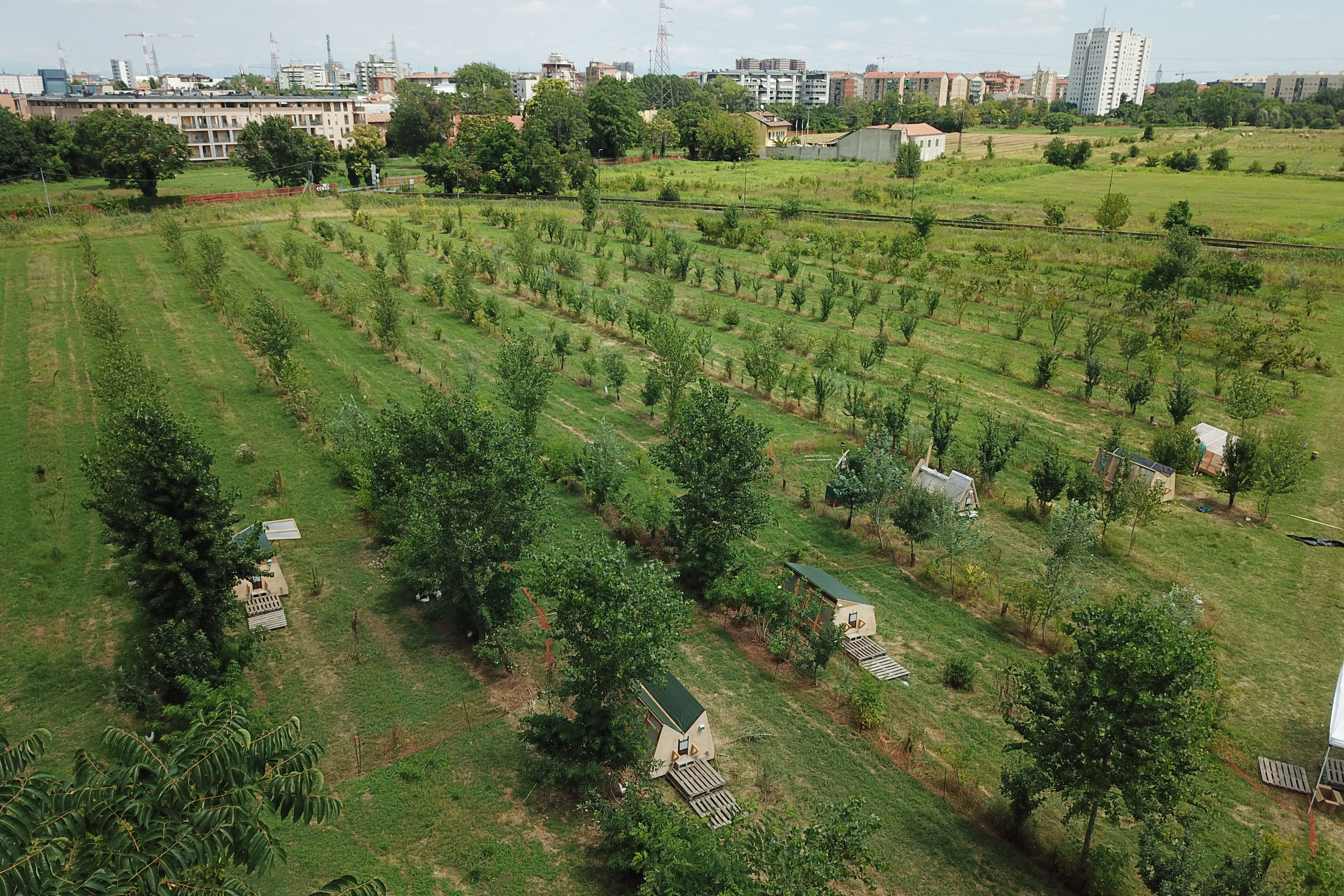Reconnecting with nature
Biblioteca del Grano di Milano
Biblioteca del Grano. Wheat Library. The bread vitality valley of Milan as a learning landscape
Biblioteca del Grano di Milano explores wheat as a universal symbol to ignite discussions on food, energy, climate, global exchanges, economy, and social justice.
It establishes a hybrid and expansive cultural space, developed from the ground up and integrated into an ecosystem of interconnected spaces, reimagining an urban fringe as a model for the city of the future, transforming this land as a learning landscape, a Valley of Bread’s Vitality.
It establishes a hybrid and expansive cultural space, developed from the ground up and integrated into an ecosystem of interconnected spaces, reimagining an urban fringe as a model for the city of the future, transforming this land as a learning landscape, a Valley of Bread’s Vitality.
Italy
Local
Milan
It addresses urban-rural linkages
It refers to other types of transformations (soft investment)
Yes
2024-12-31
No
No
No
As a representative of an organisation, in partnership with other organisations
Biblioteca del Grano di Milano is a "learning landscape", a multifunctional device designed for reconnecting with nature, blending artistic installations, open-air classrooms, and cultivated wheat fields.
It’s located in a unique area where the city meets the countryside, just 5 km from the city centre. This landscape was historically a cradle of agriculture, shaped by the ancient monks, but in modern times, it has turned into an agricultural desert.
Today, as in the past, the project is helping regenerate this area within Milan’s first agro-silvopastoral system, which, in collaboration with local farms, produces the city’s first locally grown bread and pasture-raised eggs.
Biblioteca del Grano is an experimental and multifunctional field, activating a new green infrastructure through the agroforestry technique of alley cropping, which interweaves rows of tree speciesì, either tall-growing or coppiced, alternating with wheat-cultivated strips.
It serves as a laboratory-observatory of interrelations, focused on transdisciplinary artistic research exploring the Art-Climate nexus.
Operating in a complex, far-from-bucolic context, in one of the most polluted fringe areas of Europe, the project raises critical questions about local food production, water scarcity, and the need for phytoremediation interventions.
Over three years of activity, it has engaged participants, adopting an inclusive approach open to socially fragile groups who are typically excluded from cultural experiences, such as neighbourhood children from economically disadvantaged families and other vulnerable individuals, also providing donations of bread and eggs.
Groups of stakeholders from various disciplines has been involved, including farmers, bakers, chefs, artists, researchers, and students.
The initiative has provided a non-formal learning path to foster advanced cultural change, along with workshops, artist residencies, and projects positioned at the intersection of art and climate.
It’s located in a unique area where the city meets the countryside, just 5 km from the city centre. This landscape was historically a cradle of agriculture, shaped by the ancient monks, but in modern times, it has turned into an agricultural desert.
Today, as in the past, the project is helping regenerate this area within Milan’s first agro-silvopastoral system, which, in collaboration with local farms, produces the city’s first locally grown bread and pasture-raised eggs.
Biblioteca del Grano is an experimental and multifunctional field, activating a new green infrastructure through the agroforestry technique of alley cropping, which interweaves rows of tree speciesì, either tall-growing or coppiced, alternating with wheat-cultivated strips.
It serves as a laboratory-observatory of interrelations, focused on transdisciplinary artistic research exploring the Art-Climate nexus.
Operating in a complex, far-from-bucolic context, in one of the most polluted fringe areas of Europe, the project raises critical questions about local food production, water scarcity, and the need for phytoremediation interventions.
Over three years of activity, it has engaged participants, adopting an inclusive approach open to socially fragile groups who are typically excluded from cultural experiences, such as neighbourhood children from economically disadvantaged families and other vulnerable individuals, also providing donations of bread and eggs.
Groups of stakeholders from various disciplines has been involved, including farmers, bakers, chefs, artists, researchers, and students.
The initiative has provided a non-formal learning path to foster advanced cultural change, along with workshops, artist residencies, and projects positioned at the intersection of art and climate.
agroforestry
ecosystem services
bread making
learning landscape
living lab
The project has REGENERATED a one-hectare agricultural field, previously abandoned and at risk of desertification, transforming it into a refuge territory for biodiversity and soil health.
The project has REUSED a system of containers as food laboratories for the production of bread and fermented vegetables.
The project has CLOSED THE LOOP by experimenting with the production of materials from waste straws.
The project has become an exemplary model of cultural space for artistic research at the intersection of disciplines.
It has evolved into an open-air classroom of MadreProject, the School of Bread and Places, the first school for aspiring bread entrepreneurs to regenerate territories through bread.
The project promotes awareness of the place and heritage in all its diversity, designing functional spaces for the creation of favourable microclimates, vegetation development and ecological enhancement in terms of biodiversity, soil fertility, and land use. In addition to productive goals such as the production of the first Milanese agricultural bread, crafted by Davide Longoni, a legend of the "new wave of bread”.
It also involves egg production through peri-urban agro-silvopastoral systems, activating participatory, and solidarity-based micro-supply chains.
The project aims to restore the peri-urban territory’s capacity to generate multiple ecosystem services.
Universities monitor the ecological and cultural benefits produced. A recent study (https://doi.org/10.3390/su151411020) estimated that expanding these initiatives across the entire peri-urban area of Corvetto-Vettabbia-Chiaravalle would increase life-supporting ecosystem services by 44% and natural regulation services by 36%. Even purely agricultural areas would see a 15% increase in their regulation ecosystem services, which are essential for addressing peri-urban climatic and environmental instability, while cultural ecosystem services supported by peri-urban agricultural fields would grow by 21%.
The project has REUSED a system of containers as food laboratories for the production of bread and fermented vegetables.
The project has CLOSED THE LOOP by experimenting with the production of materials from waste straws.
The project has become an exemplary model of cultural space for artistic research at the intersection of disciplines.
It has evolved into an open-air classroom of MadreProject, the School of Bread and Places, the first school for aspiring bread entrepreneurs to regenerate territories through bread.
The project promotes awareness of the place and heritage in all its diversity, designing functional spaces for the creation of favourable microclimates, vegetation development and ecological enhancement in terms of biodiversity, soil fertility, and land use. In addition to productive goals such as the production of the first Milanese agricultural bread, crafted by Davide Longoni, a legend of the "new wave of bread”.
It also involves egg production through peri-urban agro-silvopastoral systems, activating participatory, and solidarity-based micro-supply chains.
The project aims to restore the peri-urban territory’s capacity to generate multiple ecosystem services.
Universities monitor the ecological and cultural benefits produced. A recent study (https://doi.org/10.3390/su151411020) estimated that expanding these initiatives across the entire peri-urban area of Corvetto-Vettabbia-Chiaravalle would increase life-supporting ecosystem services by 44% and natural regulation services by 36%. Even purely agricultural areas would see a 15% increase in their regulation ecosystem services, which are essential for addressing peri-urban climatic and environmental instability, while cultural ecosystem services supported by peri-urban agricultural fields would grow by 21%.
We have RE-ACTIVATED a unique landscape fragment, an ancient cradle of European agriculture, that had been compromised by modernity, transforming it into a scientific and artistic research laboratory at the intersection of disciplines. It serves as a generative laboratory for nature-based solutions, a learning landscape where participants can cultivate their ability to aspire.
The Biblioteca del Grano di Milano is a landscape project that integrates existing agrarian geometries, emphasizing the plains and the movement of water through springs, canals, historic farmsteads, and millennia-old abbeys. This ancient monastic land, with its centuries-old abbey forest, draws on Leonardo’s legacy, referencing flood meadows and reinterpreting them in a contemporary key, structuring the fields with a golden ratio module. It activates the cultural, social, and natural qualities of a place to create unique and positive experiences.
We have CONNECTED different groups and communities through an intense program of meaningful experiences, which over time have fostered a sense of belonging to the territory.
This renewed community attachment has driven a process of INTEGRATION, proposing a new territorial vision for Chiaravalle, transforming it from a modernity-forgotten periphery into a resilient neighbourhood, a model for the city of the future. This initiative has already been recognized with a mention at the Venice Architecture Biennale – Italy Pavilion 2021, Resilient Communities.
This territorial vision, which inspires both Milan and the world, has led to the nomination of Chiaravalle as a UNESCO landscape, supported by the Department of Culture of the City of Milan.
The Biblioteca del Grano di Milano is a landscape project that integrates existing agrarian geometries, emphasizing the plains and the movement of water through springs, canals, historic farmsteads, and millennia-old abbeys. This ancient monastic land, with its centuries-old abbey forest, draws on Leonardo’s legacy, referencing flood meadows and reinterpreting them in a contemporary key, structuring the fields with a golden ratio module. It activates the cultural, social, and natural qualities of a place to create unique and positive experiences.
We have CONNECTED different groups and communities through an intense program of meaningful experiences, which over time have fostered a sense of belonging to the territory.
This renewed community attachment has driven a process of INTEGRATION, proposing a new territorial vision for Chiaravalle, transforming it from a modernity-forgotten periphery into a resilient neighbourhood, a model for the city of the future. This initiative has already been recognized with a mention at the Venice Architecture Biennale – Italy Pavilion 2021, Resilient Communities.
This territorial vision, which inspires both Milan and the world, has led to the nomination of Chiaravalle as a UNESCO landscape, supported by the Department of Culture of the City of Milan.
Bread is a polysemic subject. It tells humanity’s history and serves as a symbol across different beliefs, making it a vehicle for intercultural dialogue.
Bread is also the Mediterranean’s biography, it speaks of exploitation, wars, climate migrations, and new forms of poverty.
The Mediterranean diet is an invention. The poor and exploited have always eaten bread made from lesser grains, often adulterated or even drugged to stave off hunger. In the Middle Ages, wheat was reserved for the tables of the wealthy.
Bread also challenges us to question identity. The debate over durum wheat, from which the quintessentially Italian spaghetti is made, traces its origins to Islamic agricultural innovations in the 9th century, introduced during the "Arab Agricultural Revolution" (A. M. Watson).
Thus, bread opens up discussions on new forms of poverty, climate migrations, and ecosystem health.
By exploring bread, Biblioteca del Grano has developed inclusive activities, embracing different cultures and physical abilities, and engaging individuals who are typically excluded from cultural initiatives.
The project's experiential nature, including sowing wheat, baking bread together, and planting trees, has broadened its inclusivity to a diverse range of participants, including those with different physical and cognitive abilities. While sign language facilitators are not yet available, plans are in place to introduce them soon.
The project offers thousands, ensuring access to site-specific artistic and participatory experiences, even for those with limited economic resources. It provides opportunities for families from public housing in Corvetto to enjoy life in an accessible green space.
Services tailored to different groups include a community social oven, a collaborative kitchen, and a social chicken coop, which have already distributed hundreds of kilograms of agricultural bread and organic eggs to those in need, thanks to partnerships with social enterprises.
Bread is also the Mediterranean’s biography, it speaks of exploitation, wars, climate migrations, and new forms of poverty.
The Mediterranean diet is an invention. The poor and exploited have always eaten bread made from lesser grains, often adulterated or even drugged to stave off hunger. In the Middle Ages, wheat was reserved for the tables of the wealthy.
Bread also challenges us to question identity. The debate over durum wheat, from which the quintessentially Italian spaghetti is made, traces its origins to Islamic agricultural innovations in the 9th century, introduced during the "Arab Agricultural Revolution" (A. M. Watson).
Thus, bread opens up discussions on new forms of poverty, climate migrations, and ecosystem health.
By exploring bread, Biblioteca del Grano has developed inclusive activities, embracing different cultures and physical abilities, and engaging individuals who are typically excluded from cultural initiatives.
The project's experiential nature, including sowing wheat, baking bread together, and planting trees, has broadened its inclusivity to a diverse range of participants, including those with different physical and cognitive abilities. While sign language facilitators are not yet available, plans are in place to introduce them soon.
The project offers thousands, ensuring access to site-specific artistic and participatory experiences, even for those with limited economic resources. It provides opportunities for families from public housing in Corvetto to enjoy life in an accessible green space.
Services tailored to different groups include a community social oven, a collaborative kitchen, and a social chicken coop, which have already distributed hundreds of kilograms of agricultural bread and organic eggs to those in need, thanks to partnerships with social enterprises.
The relationship between citizens and the project develops according to a scale of varying intensity.
At the basic level of involvement, there is interaction with citizens who are sensitive to environmental and cultural issues and participate in cultural activities of which they have become aware, as users, or with inhabitants who live in the peripheral districts and enjoy the green spaces and agroforestry.
The project adopts a participatory approach that involves citizens in collaborative relationship models. For example, the hundreds of people who participated in the Civic Crowdfunding for the activation of MadreProject, a satellite project to this one; teachers and children from local schools; students from the bread school and agroecology programmes; the adopters of the hens, who are involved in co-planning processes and participated in the crowdfunding to activate the project.
The project has enabled the creation of a territorial educational pact for the Corvetto-Vettabbia-Chiaravalle area, bringing together an ecosystem that includes research institutions, cultural organizations, public schools, businesses, farmers and artisans, artists, civil society, and local citizens in a culture-driven urban regeneration project.
Citizen involvement has gone far beyond simply participating in cultural activities or using public spaces, it has actively engaged them. This includes wheat-sowing events with thousands of children, a community of hen adopters, tree-planting initiatives, and collective bread-making rituals.
One of the key impacts has been the emergence of a strong sense of belonging to the place, which has even led to the formation of a citizens' committee opposing the construction of a stadium, a movement that appears to have successfully halted the project.
At the basic level of involvement, there is interaction with citizens who are sensitive to environmental and cultural issues and participate in cultural activities of which they have become aware, as users, or with inhabitants who live in the peripheral districts and enjoy the green spaces and agroforestry.
The project adopts a participatory approach that involves citizens in collaborative relationship models. For example, the hundreds of people who participated in the Civic Crowdfunding for the activation of MadreProject, a satellite project to this one; teachers and children from local schools; students from the bread school and agroecology programmes; the adopters of the hens, who are involved in co-planning processes and participated in the crowdfunding to activate the project.
The project has enabled the creation of a territorial educational pact for the Corvetto-Vettabbia-Chiaravalle area, bringing together an ecosystem that includes research institutions, cultural organizations, public schools, businesses, farmers and artisans, artists, civil society, and local citizens in a culture-driven urban regeneration project.
Citizen involvement has gone far beyond simply participating in cultural activities or using public spaces, it has actively engaged them. This includes wheat-sowing events with thousands of children, a community of hen adopters, tree-planting initiatives, and collective bread-making rituals.
One of the key impacts has been the emergence of a strong sense of belonging to the place, which has even led to the formation of a citizens' committee opposing the construction of a stadium, a movement that appears to have successfully halted the project.
The project is realized by Terzo Paesaggio and Soulfood Forestfarms, in collaboration with Avanzi spa and Cum Panis srl (Davide Longoni’s Bakery), which contributed to realize MadreProject.
The Municipality of Milan has supported the project through specific grants from various Departments and Units, including: Department of Culture; MUDEC - Museum of Cultures; Department of Economic Development and Labor Policies; Youth Promotion and Transition Division; Districts 4 and 5 of the Municipality.
The project has also garnered interest from the Food Policy Directorate, particularly the Agriculture Unit and the Food Poverty Unit, due to its focus on engaging children and vulnerable youth.
Italian Ministry of Culture has supported specific actions, especially regarding artistic experimentation and territorial rebalancing of cultural initiatives in urban peripheries.
Several private foundations have contributed to the project, including Moleskine Foundation, which involved 50 cultural innovators from around the world in a collective wheat-sowing action. Other key partners: Fondazione di Comunità Milano and Fondazione Cariplo, which support the project's promoting organizations.
The project operates within framework agreements: University of Milan, Departments of Cultural and Environmental Heritage and Agricultural and Environmental Sciences; Polytechnic University of Milan, Department of Architecture and Urban Studies, which actively contributes to the project’s scientific research and implementation processes.
Stakeholders guarantee economic support and know-how and also participate and collaborate actively to promote the themes of urban regeneration, food production from local supply chains, environmental sustainability and access to public green spaces for psychophysical well-being, as well as ecological and energy transition.
All this aligns with the strategic plans of the metropolitan city and the Municipality: PGT, C40Cities, Welfare Plan, ‘15-min city’.
The Municipality of Milan has supported the project through specific grants from various Departments and Units, including: Department of Culture; MUDEC - Museum of Cultures; Department of Economic Development and Labor Policies; Youth Promotion and Transition Division; Districts 4 and 5 of the Municipality.
The project has also garnered interest from the Food Policy Directorate, particularly the Agriculture Unit and the Food Poverty Unit, due to its focus on engaging children and vulnerable youth.
Italian Ministry of Culture has supported specific actions, especially regarding artistic experimentation and territorial rebalancing of cultural initiatives in urban peripheries.
Several private foundations have contributed to the project, including Moleskine Foundation, which involved 50 cultural innovators from around the world in a collective wheat-sowing action. Other key partners: Fondazione di Comunità Milano and Fondazione Cariplo, which support the project's promoting organizations.
The project operates within framework agreements: University of Milan, Departments of Cultural and Environmental Heritage and Agricultural and Environmental Sciences; Polytechnic University of Milan, Department of Architecture and Urban Studies, which actively contributes to the project’s scientific research and implementation processes.
Stakeholders guarantee economic support and know-how and also participate and collaborate actively to promote the themes of urban regeneration, food production from local supply chains, environmental sustainability and access to public green spaces for psychophysical well-being, as well as ecological and energy transition.
All this aligns with the strategic plans of the metropolitan city and the Municipality: PGT, C40Cities, Welfare Plan, ‘15-min city’.
The project adopts a transdisciplinary approach, weaving together a meshwork of themes spanning vast disciplinary distances.
On one side, it integrates agroforestry, scientific research on soil health, chemistry, and the study of minerals, along with the symbiotic relationships among plants, bacteria, and fungi, which are fundamental to carbon sequestration and soil storage. It also engages artisan knowledge, bread-making, fermentation, and food systems.
It extends through philosophy, biophilia, and anthropology, tackling issues such as social injustice, identity, feminism, coexistence among living entities, non-human forms of intelligence, and the hyperobject scale of the climate crisis.
It incorporates architecture and landscape design, and artistic and performative research, with a strong focus on participatory artistic practices, active community engagement, and site-specific interventions.
This vibrant community of practice, composed of experts and supported by academic research, has ultimately positioned Corvetto-Vettabbia-Chiaravalle as a Living Lab for resilience.
The added value of this interweaving of disciplines is given by the positioning of the Biblioteca del Grano di Milano as a place for ecological imagination, creating a unique space that we have begun to call ‘learning landscapes’, a cultural space where learning takes place in experiential practices, in the spaces between things, making bread, transforming food, planting trees and at the same time transforming a part of the city.
The project involves professionals and the local population, for example, the artisan knowledge of vegetable gardeners, farmers and local mothers with a migrant background who bring their knowledge to the project.
Together with public institutions and social enterprise partners, we have established Milan's first Renewable Energy Solidarity Community, CercaMI.
We have also initiated the co-design process for Chiaravalle’s nomination as a UNESCO World Heritage Site.
On one side, it integrates agroforestry, scientific research on soil health, chemistry, and the study of minerals, along with the symbiotic relationships among plants, bacteria, and fungi, which are fundamental to carbon sequestration and soil storage. It also engages artisan knowledge, bread-making, fermentation, and food systems.
It extends through philosophy, biophilia, and anthropology, tackling issues such as social injustice, identity, feminism, coexistence among living entities, non-human forms of intelligence, and the hyperobject scale of the climate crisis.
It incorporates architecture and landscape design, and artistic and performative research, with a strong focus on participatory artistic practices, active community engagement, and site-specific interventions.
This vibrant community of practice, composed of experts and supported by academic research, has ultimately positioned Corvetto-Vettabbia-Chiaravalle as a Living Lab for resilience.
The added value of this interweaving of disciplines is given by the positioning of the Biblioteca del Grano di Milano as a place for ecological imagination, creating a unique space that we have begun to call ‘learning landscapes’, a cultural space where learning takes place in experiential practices, in the spaces between things, making bread, transforming food, planting trees and at the same time transforming a part of the city.
The project involves professionals and the local population, for example, the artisan knowledge of vegetable gardeners, farmers and local mothers with a migrant background who bring their knowledge to the project.
Together with public institutions and social enterprise partners, we have established Milan's first Renewable Energy Solidarity Community, CercaMI.
We have also initiated the co-design process for Chiaravalle’s nomination as a UNESCO World Heritage Site.
The innovative aspect of the project lies in proposing a wheat field as a model for a cultural centre of the future, thus experimenting with a socially engaged approach to art from a post-human agency perspective.
The fracture is becoming the political norm of the contemporary world, to which the project opposes care practices through experiential and transdisciplinary approaches, touching the things of the world.
To achieve this, the project interweaves three disciplinary areas in a meshwork:
1. Research on non-formal pedagogies, activating MadreProject, Scuola del Pane e dei Luoghi (School of Bread and Places). The Scuola del Pane e dei Luoghi is a unique school inviting participants to approach bread as a way to connect local communities, places, and practices. The idea is to train members of the community to care for the environment, future entrepreneurs who can create social impact and maintain a dialogue with the context in which they operate, and bread makers who are aware of the network they are part of and the benefits of an all-round approach.
2. The cultural program favours an in situ and in vivo approach. Workshops, artistic residencies, talks, and immersive campuses involve artists, chefs, artisans, and farmers in relation to local communities.
3. The architectural and landscape project. The project creates a new fragment of landscape as a green infrastructure that holds together different design levels, aspects of environmental sustainability and agro-ecological systems, formal aspects of landscape design and the golden ratio, as well as community aspects.
The fracture is becoming the political norm of the contemporary world, to which the project opposes care practices through experiential and transdisciplinary approaches, touching the things of the world.
To achieve this, the project interweaves three disciplinary areas in a meshwork:
1. Research on non-formal pedagogies, activating MadreProject, Scuola del Pane e dei Luoghi (School of Bread and Places). The Scuola del Pane e dei Luoghi is a unique school inviting participants to approach bread as a way to connect local communities, places, and practices. The idea is to train members of the community to care for the environment, future entrepreneurs who can create social impact and maintain a dialogue with the context in which they operate, and bread makers who are aware of the network they are part of and the benefits of an all-round approach.
2. The cultural program favours an in situ and in vivo approach. Workshops, artistic residencies, talks, and immersive campuses involve artists, chefs, artisans, and farmers in relation to local communities.
3. The architectural and landscape project. The project creates a new fragment of landscape as a green infrastructure that holds together different design levels, aspects of environmental sustainability and agro-ecological systems, formal aspects of landscape design and the golden ratio, as well as community aspects.
The project distinguishes itself through a participatory approach and a translocal dimension that, starting from the project site, embraces the entire city, attempting to open discussions on the idea of the contemporary city.
Bread here is not investigated as an object. What is proposed is a path of relationship with bread, what the philosopher Nicola Perullo defines as haptic perception, that is, the creativity of touch. Haptic perception is easy to practice, it does not require expertise, but the desire to learn to learn (Making, Tim Ingold) to walk together with the things of the world, touching them. We transform ourselves with bread, with the subsoil, the roots, the sky, the earth, the air, the sun, the plants, and the ears of wheat.
This has been achieved thanks to the instrument of Service Learning, the union of service (citizenship, solidarity actions, volunteering for communities) with Learning (the acquisition of professional, methodological, social and, above all, didactic skills) which offers the possibility of creating bridges between schools and territories, neighbourhoods and cities.
Finally, it is a pioneering project for promoting advocacy processes on phytoremediation and local development, promoting city-making paths for the Corvetto-Vettabbia-Chiaravalle area in Milan as a Living Lab for resilience.
Bread here is not investigated as an object. What is proposed is a path of relationship with bread, what the philosopher Nicola Perullo defines as haptic perception, that is, the creativity of touch. Haptic perception is easy to practice, it does not require expertise, but the desire to learn to learn (Making, Tim Ingold) to walk together with the things of the world, touching them. We transform ourselves with bread, with the subsoil, the roots, the sky, the earth, the air, the sun, the plants, and the ears of wheat.
This has been achieved thanks to the instrument of Service Learning, the union of service (citizenship, solidarity actions, volunteering for communities) with Learning (the acquisition of professional, methodological, social and, above all, didactic skills) which offers the possibility of creating bridges between schools and territories, neighbourhoods and cities.
Finally, it is a pioneering project for promoting advocacy processes on phytoremediation and local development, promoting city-making paths for the Corvetto-Vettabbia-Chiaravalle area in Milan as a Living Lab for resilience.
The project aims to create a replicable and scalable model of a hybrid cultural space for other contexts, with the goal of establishing a network of “Wheat Libraries” to de-zombify bread, connecting Rome, the Tammaro Valley, Agrigento and Bethlehem.
A Wheat Library is currently being established in the village of Morcone, an inland area at risk of depopulation in the Sannio Apennines between Campania and Molise, where Terzo Paesaggio has initiated an urban regeneration project as part of the National Recovery and Resilience Plan.
This transferred project is attracting interest from other groups of beneficiaries, such as local entities and civil society, local institutions (Municipality of Morcone, local public schools), farmers, millers, bakers, and micro-pasta factories of the Tammaro Valley, and students from southern Italy.
The replicability specifically concerns the methodology oriented towards the urban regeneration project and the systemic and cultural crossover approach. In Morcone, efforts are underway to activate a “Wheat Community” of the Tammaro Valley, with the participatory sowing of a Saragolla wheat field (a local variety) by children, and the design and activation of a Community Oven that regenerates a disused public building, also developing new formats of MadreProject, Scuola del Pane e dei Luoghi. The Biblioteca del Grano di Milano is an experimental agricultural field that promotes biodiversity and education and cultivates ancient grains.
It acts as a space for co-design, shared cultivation, artistic practices and performances, and participatory activities. It is also a centre for contemporary cultural production and experimentation in pedagogies and non-formal education.
The Biblioteca del Grano has established informal educational agreements with public schools in Milan, involving teachers, children, and families. It is open to installations, workshops, meetings, projects, and studies on landscape as a field of negotiation
A Wheat Library is currently being established in the village of Morcone, an inland area at risk of depopulation in the Sannio Apennines between Campania and Molise, where Terzo Paesaggio has initiated an urban regeneration project as part of the National Recovery and Resilience Plan.
This transferred project is attracting interest from other groups of beneficiaries, such as local entities and civil society, local institutions (Municipality of Morcone, local public schools), farmers, millers, bakers, and micro-pasta factories of the Tammaro Valley, and students from southern Italy.
The replicability specifically concerns the methodology oriented towards the urban regeneration project and the systemic and cultural crossover approach. In Morcone, efforts are underway to activate a “Wheat Community” of the Tammaro Valley, with the participatory sowing of a Saragolla wheat field (a local variety) by children, and the design and activation of a Community Oven that regenerates a disused public building, also developing new formats of MadreProject, Scuola del Pane e dei Luoghi. The Biblioteca del Grano di Milano is an experimental agricultural field that promotes biodiversity and education and cultivates ancient grains.
It acts as a space for co-design, shared cultivation, artistic practices and performances, and participatory activities. It is also a centre for contemporary cultural production and experimentation in pedagogies and non-formal education.
The Biblioteca del Grano has established informal educational agreements with public schools in Milan, involving teachers, children, and families. It is open to installations, workshops, meetings, projects, and studies on landscape as a field of negotiation
The project has addressed key global challenges: climate change, biodiversity loss, and ecosystem degradation, providing local solutions. It has experimented with a new model of cultural space that has adopted nature-based solutions (NbS) to regulate water flows, propose reforestation actions, and promote soil conservation.
The experimented model of cultural space thus places the most urgent social and environmental issues of our time at the centre of cultural activity. Having a physical and tangible space to get hands-on (making bread) and in the soil (cultivating) and doing it in a participatory way, through engagement with diverse groups and communities, has allowed reflection on local issues in the Corvetto-Vettabbia-Chiaravalle area, such as heat waves, biodiversity loss, carbon sequestration, and the production and access to healthy and fair food
The project generates European added value as it prototypes a new model of cultural space for ecological imagination which can be repeated in different contexts.
The experimented model of cultural space thus places the most urgent social and environmental issues of our time at the centre of cultural activity. Having a physical and tangible space to get hands-on (making bread) and in the soil (cultivating) and doing it in a participatory way, through engagement with diverse groups and communities, has allowed reflection on local issues in the Corvetto-Vettabbia-Chiaravalle area, such as heat waves, biodiversity loss, carbon sequestration, and the production and access to healthy and fair food
The project generates European added value as it prototypes a new model of cultural space for ecological imagination which can be repeated in different contexts.
The project has proposed a path of reconnection with the earth that has involved specific target groups:
-120 Families in vulnerable situations who receive donations of eggs and bread through 4 local associations for assistance and social integration in stable collaboration (Casa Pace, Pane Quotidiano, Comitato Molise-Calvairate, Unica).
-2000 Children from 8 local schools: kindergarten and primary school.
-100 Aspiring bread entrepreneurs, such as people changing their lives.
-300 Young people and students interested in practices of reconnection with the earth, agroecology, and phytoremediation.
-300 Community of artists, practitioners, architects, and designers.
-2 Unaccompanied minors hosted in reception projects.
-Population of the city looking for cultural consumption.
-200 Inhabitants of the neighboring districts who have adopted a hen.
-3 Hectares of agricultural fields regenerated through agroforestry.
-13,000 trees planted, including 1500 fruit trees.
-12 theoretical-practical workshops on agroecology and agroforestry.
-6 Workshops with university students and a Summer school
-15 Planting events and collective sowing.
-1 Festival on the theme of the egg from a cultural perspective.
Indirect beneficiaries, CERS (Renewable Energy Solidarity Community) and the application process of Chiaravalle as a UNESCO landscape.
No. 39 events in 2022 with a total of 2950 attendances with artists; to name a few: Esperance Hakuzwimana, Paolo Pecere, Alberto Gipponi, Taiko Do, Radio Raheem, Corp Ilaria Turba, Dom.
No. 45 events in 2023 with a total of 4080 attendances with artists, to name a few: Strijbos & Van Rijswijk, Suranga Katugampala (Italian Council Winner), Isabella Bordoni, Neunau.
No. 41 events in 2024 with a total of 3800 attendances, with artists, to name a few: Bayo Akomolafe, MadreProject, Scuola del Pane e dei Luoghi, AnthroDay at Bicocca University, Arianna Vairo, Studio Azzurro, Phoebe Zeitgeist, Orizzontale,The Gramounce.
-120 Families in vulnerable situations who receive donations of eggs and bread through 4 local associations for assistance and social integration in stable collaboration (Casa Pace, Pane Quotidiano, Comitato Molise-Calvairate, Unica).
-2000 Children from 8 local schools: kindergarten and primary school.
-100 Aspiring bread entrepreneurs, such as people changing their lives.
-300 Young people and students interested in practices of reconnection with the earth, agroecology, and phytoremediation.
-300 Community of artists, practitioners, architects, and designers.
-2 Unaccompanied minors hosted in reception projects.
-Population of the city looking for cultural consumption.
-200 Inhabitants of the neighboring districts who have adopted a hen.
-3 Hectares of agricultural fields regenerated through agroforestry.
-13,000 trees planted, including 1500 fruit trees.
-12 theoretical-practical workshops on agroecology and agroforestry.
-6 Workshops with university students and a Summer school
-15 Planting events and collective sowing.
-1 Festival on the theme of the egg from a cultural perspective.
Indirect beneficiaries, CERS (Renewable Energy Solidarity Community) and the application process of Chiaravalle as a UNESCO landscape.
No. 39 events in 2022 with a total of 2950 attendances with artists; to name a few: Esperance Hakuzwimana, Paolo Pecere, Alberto Gipponi, Taiko Do, Radio Raheem, Corp Ilaria Turba, Dom.
No. 45 events in 2023 with a total of 4080 attendances with artists, to name a few: Strijbos & Van Rijswijk, Suranga Katugampala (Italian Council Winner), Isabella Bordoni, Neunau.
No. 41 events in 2024 with a total of 3800 attendances, with artists, to name a few: Bayo Akomolafe, MadreProject, Scuola del Pane e dei Luoghi, AnthroDay at Bicocca University, Arianna Vairo, Studio Azzurro, Phoebe Zeitgeist, Orizzontale,The Gramounce.

